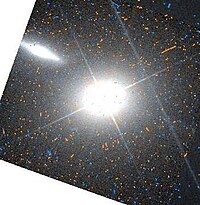Markarian 421
| Markarian 421 | |
|---|---|

Hubble Legacy Archive WFPC2 image of Mark 421 and its companion galaxy 421-5
|
|
| Observation data (Epoch J2000) | |
| Constellation | Ursa Major |
| Right ascension | 11h 04m 27.314s |
| Declination | +38° 12′ 31.80″ |
| Redshift | 0.030021 |
| Distance | 397-434 million light-years (122-133 Mpc) |
| Type | BL LAC |
| Apparent magnitude (V) | 12.9 (SIMBAD) 13.3 (NED) 11.6-16 (B Band) |
| Other designations | |
| B2 1101+38, UGC 6132, PGC 33452, 2E 2393, QSO B1101+384, Mark 421 | |
| See also: Quasar, List of quasars | |
Markarian 421 (Mrk 421, Mkn 421) is a blazar located in the constellation Ursa Major. The object is an active galaxy and a BL Lacertae object, and is a strong source of gamma rays. It is about 397 million light-years (redshift: z=0.0308 eq. 122Mpc) to 434 million light-years (133Mpc) from the Earth. It is one of the closest blazars to Earth, making it one of the brightest quasars in the night sky. It is suspected to have a supermassive black hole (SMBH) at its center due to its active nature, and has a companion galaxy (Markarian 421-5) that is fueling the gas jets observed pointing away from the galaxy.
It was first determined to be a very high energy gamma ray emitter in 1992 by M. Punch at the Whipple Observatory, and an extremely rapid outburst in very-high-energy gamma rays (15-minute rise-time) was measured in 1996 by J. Gaidos at Whipple Observatory
Markarian 421 also had an outburst in 2001 and is monitored by the Whole Earth Blazar Telescope project.
Due to its brightness (around 13.3 magnitude, max. 11.6 mag. and min. 16 mag.) the object can also be viewed by amateurs in smaller telescopes.
Coordinates: ![]() 11h 04m 27s, +38° 12′ 32″
11h 04m 27s, +38° 12′ 32″
...
Wikipedia
